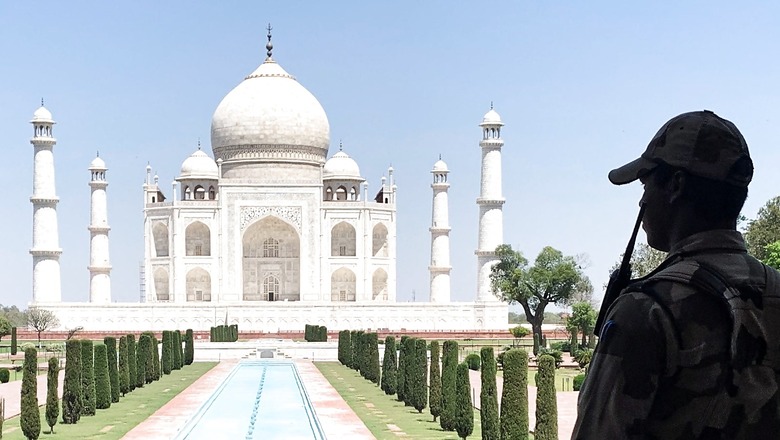
views
When it comes to protecting important installations in India, the Central Industrial Security Force (CISF) remains the top choice of the government. The force, which started with 3,129 jawans in 1969, is now the country’s third-largest paramilitary outfit with more than 1.5 lakh jawans.
The CISF protects airports, the Delhi Metro, historical monuments like the Taj Mahal, all ministries’ offices, a few important private institutions, and also dignitaries. This is the only such force that offers consultation and security analysis to various private organisations, schools, etc. The CISF is the lowest burden to the government in terms of finances as most of the money comes from the places that are under its security cover. It is a compensatory cost force.
Presently, the CISF is also providing security to protected persons classified as Z+, Z, X, Y. It is the only force with a customised and dedicated fire wing.
History
The journey of the CISF started on March 10, 1969. The force was created to guard and protect various industrial institutions of the country. But, after the hijacking of the Indian Airlines flight IC 814 in December 1999, the government of India decided to expand the deployment of the CISF and asked it to guard airports as well. In 2000, the CISF was given charge of guarding the Jaipur airport. In 2006, it was tasked to provide security to VVIPs and the force started the Special Security Group. The group started working from November 2006.
In 2007, the CISF also reached another benchmark and replaced the Delhi police from providing security to the Delhi Metro.
From the 1990s to date, the force has been given charge of securing airports, seaports, heritage monuments, nuclear power plants, and space installations. It was also deployed in Naxal-affected areas recently.
Strength and structure
The CISF is likely to reach a strength of 1.8 lakh troops in the next few years. The government is keen to augment the force after analysing threats to vital institutions from various global terror outfits.
Just like any other paramilitary force, the CISF is headed by a director general (DG)-rank officer who is from the Indian Police Service (IPS). There are four additional director general (ADG)-level officers who assist the DG. These ADG or special director general (SDG)-level officers look after the North, South, and Airport sectors, and Headquarters. The force has almost a dozen inspector general (IG)-rank officers who look after various sectors, training, etc. For the airport sector, a DIG, and deputy commandant-level officers look after the security of high-footfall airports. They are known as chief airport security officers. The fire wing of the CISF is also headed by an IG-level officer.
Stories of valour
Since the CISF is deployed to guard vital installations, there have been many instances where its troops repulsed attacks.
Its jawans are also deployed for law and order duty in various sensitive areas like Naxal-affected regions and Jammu and Kashmir and have shown extraordinary courage.
In January 2020, CISF jawans were deployed to check vehicles at Bann toll plaza in Nagrota, Jammu. They saw a truck and signalled it to stop. The troops found suspicious bags lying in the cabin of the vehicle. They overpowered the hidden terrorists who were eliminated and a huge amount of explosives was recovered.
Similarly, in 1993, the CISF was asked to guard the Hiroli Magazine at the Bailadila Iron Ore Project of the National Mineral Development Corporation Ltd in Dantewada (Chhattisgarh). The troops saw a large group of Naxals (around 500) armed with grenades, petrol bombs, firearms, etc. The Naxals launched a gruesome attack on the CISF post, asking the personnel to surrender. But the CISF troops fought bravely and stopped them from entering with a limited supply of arms. During the exchange of bullets, eight personnel of the CISF suffered severe injuries and sacrificed their lives in the discharge of duties.
Apart from this, the force has been consistently securing airports and not a single terror incident has taken place in a CISF-controlled airport.
Budget
Since the force is now reaching the next level in terms of the number of troops, the government of India has increased its budget. For 2022-23, the Centre has allocated Rs 12,201.90 crore for the CISF including a budget for modernisation.
Training
The CISF keeps updating its training charter almost every couple of years. The special tactics and training wing of the CISF’s National Industrial Security Academy provides training for special armed combat skills. It also gives training to various security agencies and the charter is based on the American specialised force SWAT (special weapons and tactics). The Quick Reaction Teams (QRTs) deployed at various airports, metro stations, and vital institutions also get training from this academy.
There are almost two dozen courses that CISF officers and jawans can pursue including arms and tactical training sessions. The Special Security Group, which covers VVIPs, also gets training from various other agencies.
Read all the Latest News India and Breaking News here




















Comments
0 comment